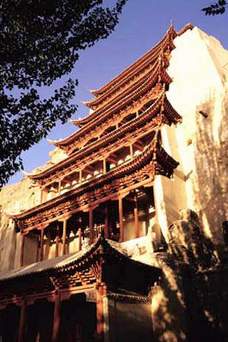|
| Related Stories |
 |
 |
|
|
General information about Dunhuang  |
|
|
 The Dunhuang Grottoes include the Mogao Grottoes, the Yulin Grottoes, the West Qianfo Grottoes, and the Lesser Qianfo Grottoes. Of them the Mogao Grottoes are the best known. The Dunhuang Grottoes include the Mogao Grottoes, the Yulin Grottoes, the West Qianfo Grottoes, and the Lesser Qianfo Grottoes. Of them the Mogao Grottoes are the best known.
As one of the world-famous art treasuries, the Mogao Grottoes or Caves of One-Thousand Buddhas, are situated 25 kilometers southeast of Dunhuang City, with invaluable murals and sculptures made between the 4th and the 14th centuries.
The 492 grottoes that remain today contain 45,000 square meters of murals, over 2,400 painted sculptures, over 4,000 flying apsarases, five wooden structures of the Tang and the Song Dynasties, and thousands of lotus-shaped pillars and floral paving tiles. A gigantic, elegant palace of art, the whole grotto complex is the world's largest, best-preserved treasure house of Buddhist scriptures, sculptures, murals, and architectural designs. It has long enjoyed the reputation of being the Bright Pearl of the Oriental Art.
The Yulin Grottoes, also called the Ten-Thousand-Buddha Gorge, lie at one key point on the Silk Road, on both of the precipitous stony banks of the Yulin River, 75 kilometers south of Anxi County.
Now there are 41 grottoes, over 100 painted sculptures, and over 1,000 square meters of murals in existence. They are indispensable component parts of the Dunhuang art. The murals of Grotto No. 25 portray plump, healthy human figures, and manifest the aesthetic characteristics of the Tang Dynasty (618--907).
Editor: Rebecca & Ronnie
Source: CCTV.com
|
|









